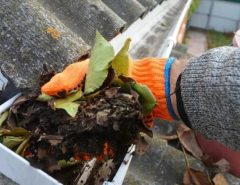Once winter is over and you start looking forward to spending more time in your yard, you need to ensure your lawn gets a well-deserved treatment. Arm yourself with enthusiasm, and let’s see how to dress your lawn up in spring.
First Things First: Raking
Although it may look like an unnecessary task because no leaves were falling during the winter, raking in spring helps you get rid of the thatch.
Thatch lies between the root systems and soil and the green vegetation of the grass. It is a dead turfgrass tissue that can harm your grass if it becomes too thick (½ inch or more).
Regardless of how well you rake your lawn in the fall, removing dead grass and preventing it from turning into thatch is the reason you need to rake your yard in the spring, too.
In addition, a lawn disease called show mold can cause grass blades to stick together, making it difficult for new grass to grow. Rake your lawn during spring to avoid this scenario.
Finally, opt for a flexible leaf rake rather than models with stiff metal tines because you don’t want to damage healthy grass.
Aerate Your Lawn
Aeration is the path to attractive and healthy lawns. It is the solution for compacted soil. However, how often you should do it depends on the soil type and the lawn’s purpose.
For instance, the best time to aerate warm-season grass is between late spring and early summer. On the other hand, aerate the cool-season varieties in fall or early spring.
Be Careful with Watering
Most of us think greenery, including grass, craves more water than we give them. However, be patient and water your plants only when they need it.
It’s challenging to determine the best watering intervals. Here’s the catch. At the beginning of the season, grass doesn’t need much water.
Remember, the roots grow first, and if the ground is dry, they penetrate deeper into the soil. That’s excellent news because grass with deep roots is more likely to survive drought.
Additional tip: Walk across the lawn. If the grass blades don’t spring back with your footsteps, that means your grass needs watering.
Take Care of Bare Spots
Weed always finds its way to bare spots on the lawn. If you want to prevent them from conquering it, fill every bare patch with grass seeds or patch it with sod.
First, you need to loosen the soil with a rake. Then, sow the seeds and cover them with fresh topsoil or cut the sod to fit the surface you want to protect and press it into the soil.
The last step is watering, which should be frequent, especially if you choose seeds.
Top-Dress Your Lawn
Top-dressing refers to fertilizing a lawn using various products that improve its look and health by forming a layer that keeps the roots cool and protects them from the sun.
Still, if you are unfamiliar with the concept and wonder how to go about top-dressing, the number one step is to choose the fertilizer. Most people opt for sand or organic compost.
However, some experts say you need a little fertilizer during spring because heavier feeding is more for cool-season grasses. In addition, over-fertilizing can cause various weed problems and lawn diseases.
Prepare the Mower for the Gardening Season
A mower is your ally during the gardening season, so you must ensure it’s clean and safe to use. Before spring mowing starts, have it looked over and serviced if necessary.
You’ll probably need help from a professional for this endeavor. The technician will see if everything works properly, including the starter, belts, air filter, battery, and spark plug.
They will also take care of the blades and ensure they are sharp enough. This part is also essential because a dull mower tends to rip rather than cut the grass. As a result, you get ragged brown tips exposed to various diseases.
Enjoy Every Step of the Process
Taking care of a lawn requires patience and time. It may look complex at first glance. However, it all comes down to proper planning. Finally, dressing your yard up can be a fun hobby, and, crucially, it is also highly beneficial to your health.




